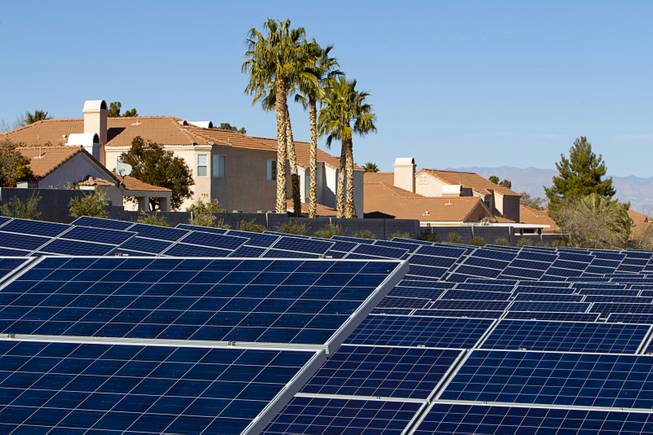
Homes are shown behind a solar photovoltaic field at Congregation Ner Tamid on Sunday, Jan. 12, 2014, in Henderson. The $1.6 million project, a partnership of Congregation Ner Tamid, NV Energy and Hamilton Solar, will produce about 75 percent of the temple’s power usage on average, said Matthew Weinberger, Hamilton Solar’s director of business development.
Published Wednesday, April 15, 2015 | 2 a.m.
Updated Wednesday, April 15, 2015 | 9:44 a.m.
Gov. Brian Sandoval will meet with solar industry officials to discuss a controversial cap that limits how many consumers can put solar panels on their homes and provide energy to the grid.
The news is a bright spot for the solar industry and the latest chapter in what’s been a behind-the-scenes battle this legislative session between solar advocates and NV Energy, the state’s dominant power provider.
The debate centers on a credit solar customers get on their energy bills that NV Energy calls a subsidy paid for by nonsolar customers. The solar industry hails the credit as a vehicle for creating emission-free energy and reducing the burden on the utility’s infrastructure as a way to cut costs in the long run. The conflict also highlights an old-vs-new clash where solar is taking a small chunk out of the revenues once protected by the utility industry’s century-old business model.
Nevada is home to one of the nation’s fastest growing rooftop solar industries and boasts the most solar jobs per capita nationally. But advocates say residential rooftop will hit a roadblock if Sandoval and lawmakers don’t act soon on a policy known as net metering.
Net metering allows homeowners to generate their own power with rooftop solar installations, supply power to the grid and generate credits for their utility bill by supplying power to the grid.
Around 2,000 NV Energy customers participate.
Currently, there is a 3 percent cap on how many Nevadans can participate. That number represents 3 percent of all utility customers consuming energy during the highest level of demand on the electric grid in a given year, which is around 7,500 megawatts.
Industry advocates say consumers will max the cap by the end of the year, potentially limiting how many people can have solar installations and jeopardizing 6,000 jobs in the state.
On Tuesday, Sandoval said he was “soon” meeting with representatives from SolarCity, a prominent residential rooftop company that leases solar panels to consumers in Nevada and nationally. Officials from the solar company, which has 1,000 employees in-state, confirmed there will be a meeting this week but declined to comment further.
Sandoval says he is neutral on the issue and waiting for both sides of the debate to unveil their arguments.
“Should those without rooftop solar pay a higher rate on their electric bill for the insertion of rooftop solar across the state?” Sandoval said on Wednesday. “… There is a concern on one side that it will raise rates to do that.”
The Sun first reported about the conflict between the solar industry and NV Energy last week. In the days since, there’s been growing speculation about whether lawmakers would submit a bill or if Sandoval would take measures to increase the cap.
With the legislative session more than halfway complete, few options remain for submitting new legislation. Party leaders can submit a limited number of emergency bills or attach language to an existing proposal.
GOP Senate Majority Leader, Michael Roberson, said he’s not been approached to submit a bill but could consider it.
“The most effective way to produce an agreement on net metering is get all stakeholders in the same room,” he said. “If during this conversation, the stakeholders reach a compromise, I would absolutely consider using an emergency measure.”
Democrats in the Senate have no plans on submitting emergency measures nor do Assembly Republicans.
In the U.S., 44 states have net metering. Colorado, Ohio and New Jersey have no caps. California is looking to do the same. New York recently doubled its cap to 6 percent.
The solar industry says it is in the crosshairs of a national campaign being led by NV Energy and its parent company, Berkshire Hathaway Energy, a conglomerate of utilities the solar industry pans as a regulated monopoly.
“It is time to put the swords down and time to get 6,000 Nevada families out of the crosshairs of its political agenda,” Bryan Miller, vice president of public policy at Sunrun, a rooftop solar company with more than 1,000 customers in Nevada and a warehouse in Las Vegas, said
NV Energy says increasing the cap will hike bills for ratepayers.
“Some customers benefit and others don’t,” Stacey Kusters, NV Energy vice president of renewable energy and origination, told the Sun last week.
CORRECTION: This story has been updated to reflect the nature of the credit solar customers receive on their energy bills. | (April 15, 2015)

Join the Discussion:
Check this out for a full explanation of our conversion to the LiveFyre commenting system and instructions on how to sign up for an account.
Full comments policy